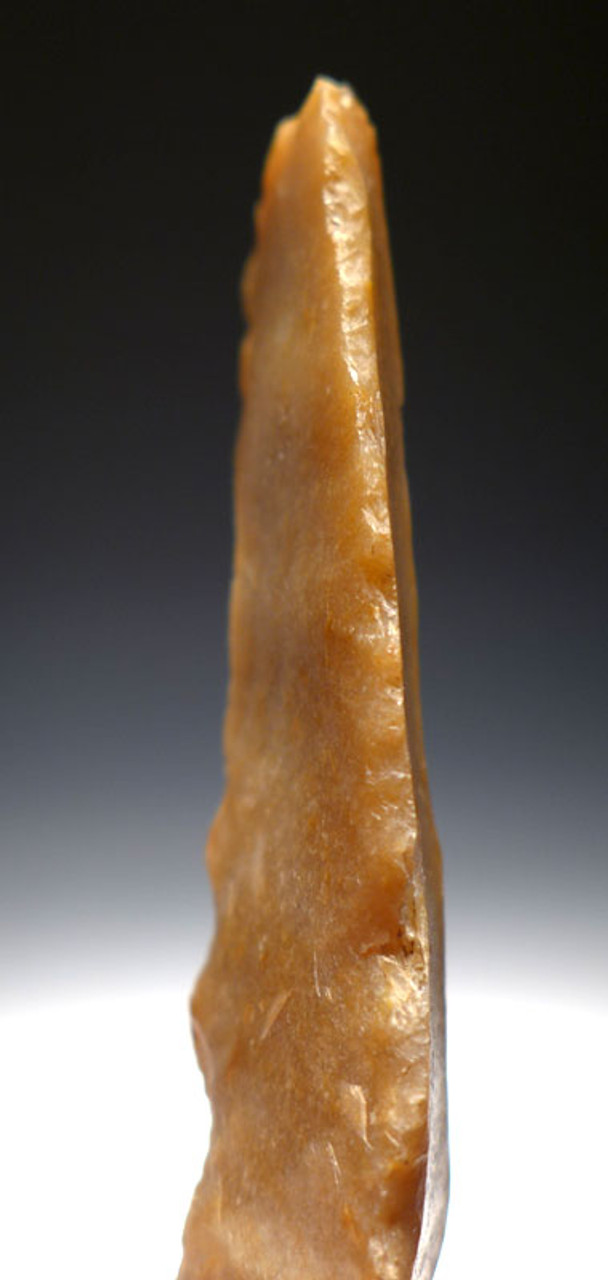Product Description
ID
|
European Neolithic Blade
|
||
FOUND
|
Spiennes, Belgium (white), Le Grand
|
||
AGE
|
NEOLITHIC PERIOD: 6000 - 5400 years ago
|
||
SIZE
|
4.3"and 4.1" long
|
||
CONDITION
|
INTACT AND COMPLETE -
|
||
NOTE
|
PERFECT MUSEUM-CLASS EXAMPLES |
||
INCLUDES DISPLAY BOX - Actual Item - One Only
Comes with a certificate of authenticity / information sheet |
|||
CLICK HERE TO LEARN MORE ABOUT EUROPEAN NEOLITHIC TOOLS
This is one of the finest sets of European Neolithic flint knives we have offered. Each is an example of a backed knife of near identical size but from two different sites that were each, amongst the most prominent sites in all of Neolithic western Europe. The golden blade is from Le Grand Pressigny in France. The white blade was found in Spiennes, Belgium. These two regions were the amongst the most important and largest trade and flint mining / manufacture centers of Neolithic Europe. Both blades were made in the same manner, struck from large prismatic flint tool cores. You could not ask for a better educational or museum reference set as these. They are both, in AS MADE condition with NO REPAIR OR RESTORATION. An excellent set of two FINEST GRADE flint knives from the major centers of Neolithic western Europe.
LE GRAND PRESSIGNY: One of the most famous flint sources of the European Neolithic Period was the golden honey toned flint from the well-known site of Le Grand Pressigny. Dating all the way back to the Acheulian Period in Europe, flint was collected from deposits in Le Grand-Pressigny in Southern Touraine, France. In the Neolithic Period, large mines were dug and worked here with the flint being traded far distances away. The flint is unmistakable in its appearance - a rich golden yellow tone with slight translucence. Most famous from the area during the Neolithic were the massive blade cores prepared called Livres de Beurre (pounds of butter) by archaeologists for the appearance. From these cores, gloriously large flint knives were struck that in some cases, exceeded lengths of 12 inches! The entire prehistoric site of Le Grand Pressigny is scientifically important and was one of the most active epicenters of trade and habitation for an extraordinary length of time in human prehistory.
SPIENNES: The declaration in the year 2000 by UNESCO protecting the Neolithic flint mines at Spiennes was highlighted by three main criteria as quoted: "1) The Neolithic mines at Spiennes provide exceptional testimony to early human inventiveness and application, 2) The arrival of Neolithic cultures marked a major milestone in human cultural and technological development, which is vividly illustrated by the vast complex of ancient flint mines at Spiennes. 3) The flint mines at Spiennes are outstanding examples of Neolithic mining of flint, which marked a seminal stage of human technological and cultural progress."
These mines cover more than 250 acres and represent the largest and earliest concentration of ancient mines in Europe! A large diversity of methods were employed to extract the flint by open quarries, pits and networks of underground horizontal galleries. Vertical tunnels range from 30 to 40 feet deep. Shafts were sunk through the chalk layer vertically with galleries radiating out from the shafts. Unique to Spiennes, when the flint was exhausted above the bedrock, the rock layer was penetrated to reach the chalk layer below. This feature shows the mastery these Neolithic humans had of their local geology!
Mines were dug with only the aid of antler picks and bone shovels demonstrating an incredible feat based on the expansiveness of the site. Despite the miners' knowledge to leave pillars in the horizontal galleries for roof support, skeletons of workers have been found in collapsed shafts at Spiennes. Flint tools from the mining site at Spiennes represent an icon of Neolithic technology, trade and culture. Every collection should have at least one tool from this official 'world-class' site.
 US DOLLAR
US DOLLAR
 EURO
EURO
 AUSTRALIAN DOLLAR
AUSTRALIAN DOLLAR
 CANADIAN DOLLAR
CANADIAN DOLLAR
 POUND STERLING
POUND STERLING














